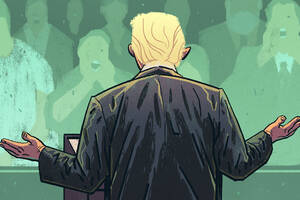Politics & Elections May 6, 2016
Abandoning the Electoral College Would Remake Campaign Spending
A direct-vote system could have a sizeable impact on the behaviors of voters and candidates.

Yevgenia Nayberg
If you live in a state like New York or Wyoming, you could easily go this entire election season without seeing a single TV ad for a presidential candidate. The states are so solidly blue or red that candidates largely do not bother trying to sway voters there. However, residents of swing states like Ohio and Florida will be pummeled with political commercials for months.
This pattern is a quirk of the Electoral College, a winner-take-all system that grants every one of a state’s electoral votes to the candidate who wins that state. And the stakes are very high. In 2000, a tiny fraction of votes in a battleground state clinched the election for George W. Bush.
The Electoral College “creates these really strong incentives for candidates to put lots of money into states that they can hopefully tip and to basically ignore everyone else,” says Brett Gordon, an associate professor of marketing at the Kellogg School.
But what if the country abandoned the Electoral College and switched to a direct-vote system, where votes are simply tallied nationally to determine the winner? How would that change presidential TV ad strategies and spending—which reached nearly $1 billion in 2012?
Gordon and Wesley Hartmann, at the Stanford Graduate School of Business, created a model to simulate a direct-vote scenario. They used their model to examine two recent presidential elections. They found that in the hotly contested 2000 race, spending would have gone up by 13 percent. But in the less tight—and likely more typical—2004 race, spending would have dropped by 54 percent.
In other words, overall, a direct-vote system could greatly reduce the amount of campaign money devoted to TV ads. This could have significant political implications. Instead of using ads, candidates might try other tactics to sway voters, such as adopting more popular policy positions.
Abolishing the Electoral College Would Erase Battleground Lines
Gordon and Hartmann drew on TV advertising data from the two presidential elections. The dataset was vast, covering 75 TV markets, which reach 78 percent of the population. The researchers calculated the average number of times each person in an area saw a political ad. They also obtained advertising prices across TV markets, as well as county-level voting results.
The researchers then developed a model to simulate how two competing presidential candidates and their outside supporting groups could most effectively allocate money for TV advertising in a direct-vote system. Each team had to decide how much money to spend on ads in various markets (which cost different amounts) from September to November of an election year to maximize their chance of winning.
If you change the Electoral College, “you’re going to change how candidates behave. And if you change how candidates behave, you might change how voters respond.”
The analysis of the 2000 election suggested, unsurprisingly, that under a direct-vote system, advertising would have dropped in battleground states and spread to former non-battleground states. Voters in swing states would have seen an average of 37 percent fewer Bush ads and 58 percent fewer ads for Al Gore. But that decrease would have been more than compensated for elsewhere. People in other states would have seen roughly twice as many ads in the model’s scenario as they did under the Electoral College. Overall, total advertising spending would have increased from $117 million to $132 million.
The results make sense because the candidates would have had to fight for votes all across the country in an extremely close race, which had a popular vote margin of less than 1%, says Gordon. “2000 was a narrow election no matter how you cut it,” he says. “Any given vote could be pivotal.”
For the 2004 election between Bush and John Kerry, the researchers saw a different pattern. Battleground advertising still dropped dramatically: Voters saw an average of 74 percent and 82 percent fewer Bush and Kerry ads, respectively. But the candidates did not make up that spending in other states. Voters in former non-battleground areas saw about the same number of Bush ads and even fewer Kerry ads than they did under the Electoral College system.
A Poor Investment in Political Ads
Why the difference between the two elections? In 2004, Bush was leading by a fairly wide margin over Kerry in many states, so investing money in advertising might have led to an unproductive arms race. Kerry could have spent, say, $1 million in one market, but Bush could easily have matched that amount. If Kerry’s ads did not lure substantially more voters than Bush’s, the money would essentially have been wasted.
And TV ads are only moderately effective. In a tight Electoral College scenario, they might garner the few hundred or thousand votes needed to tip the balance in a swing state. However, they might not sway the millions of voters needed in a direct vote, Gordon says.
So in a situation where one candidate is lagging significantly, that person may decide it is not worth it to sink money into ads.
“If I have a direct vote and I’m down by 5 points nationally, I may not be able to spend any amount of money on advertising that’s going to sway that 5 percent of voters,” Gordon says. “It’s just too many voters.” Instead, the candidate may try to pull ahead by visiting states in person more frequently or changing policy positions to appeal to more people.
Ripple Effects
Gordon and Hartmann also explored how candidates’ advertising strategies under a direct-vote system would influence election outcomes, like voter turnout and choice—and even the winner of an election.
People assume that Gore would have won the 2000 election under a direct-vote system—after all, he received more votes than Bush. But Gordon points out that the candidates would have campaigned differently in such an election, and those changes can have ripple effects.
“If you change that system, you’re going to change how candidates behave,” he says. “And if you change how candidates behave, you might change how voters respond.”
The team modelled how altered advertising strategies would affect voter behavior. For the 2000 election, the researchers found that Bush would have won the popular vote in four more states: Iowa, New Mexico, Oregon, and Wisconsin. However, Gore still would have retained the overall lead by about 390,000 votes. Similarly, for the 2004 election, Bush still would have prevailed over Kerry.
Free Publicity
The results do not have implications for TV advertising in the current presidential election, since the Electoral College system stands. But Gordon notes that Donald Trump has grabbed voters’ attention in other ways.
“Trump has been a great example of someone who has clearly mastered free publicity,” he says. “Why pay for ads on TV when you can guarantee that you’re going to have the media cover him anyway?” In a direct-vote scenario, he says, perhaps more candidates would adopt this more “organic” form of advertising.
As for whether a direct vote would ultimately benefit the country, Gordon does not have a clear answer. A reduction in TV advertising could be seen as positive or negative, depending on whether you think ads help people make more informed choices, provide little useful content, or actually deceive voters. What he can say is that, given the nature of a direct vote, candidates would have to appeal to a broader voter base.
“Whether that in the end makes the country better off, whether or not that solves all of politics’ problems—there does not exist a model that can tell you the answer to that question.”
Gordon, Brett R., and Wesley R. Hartmann. In press. “Advertising Competition in Presidential Elections.” Quantitative Marketing and Economics.



